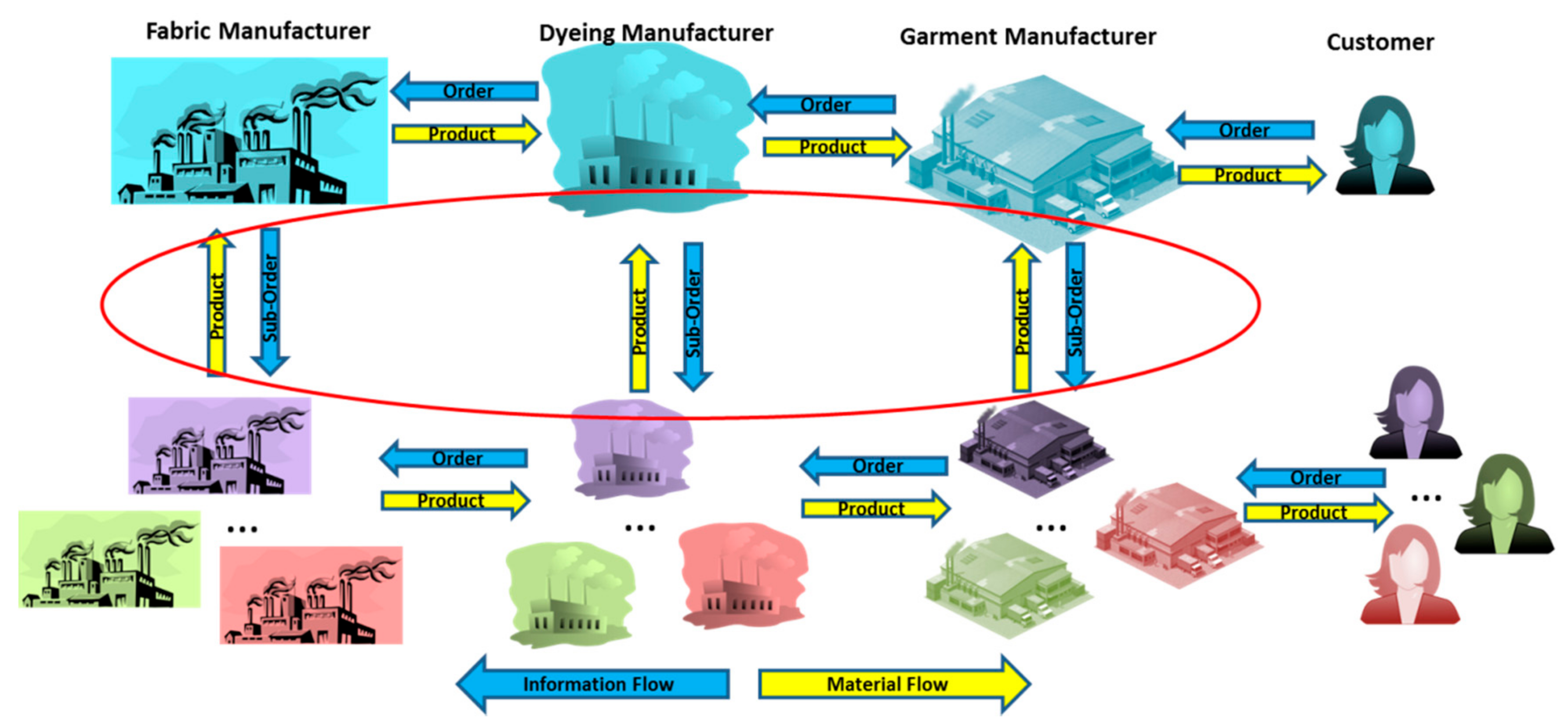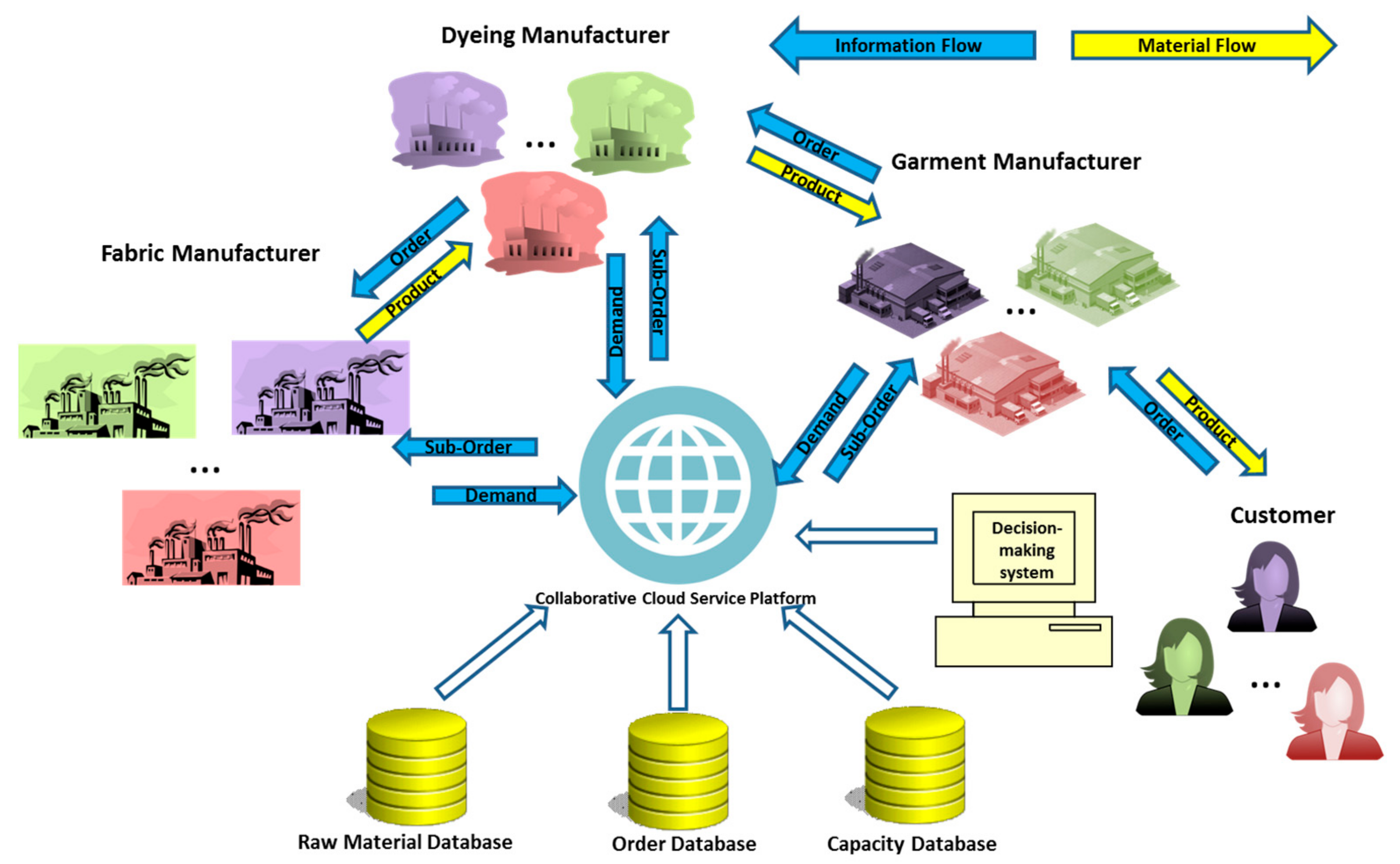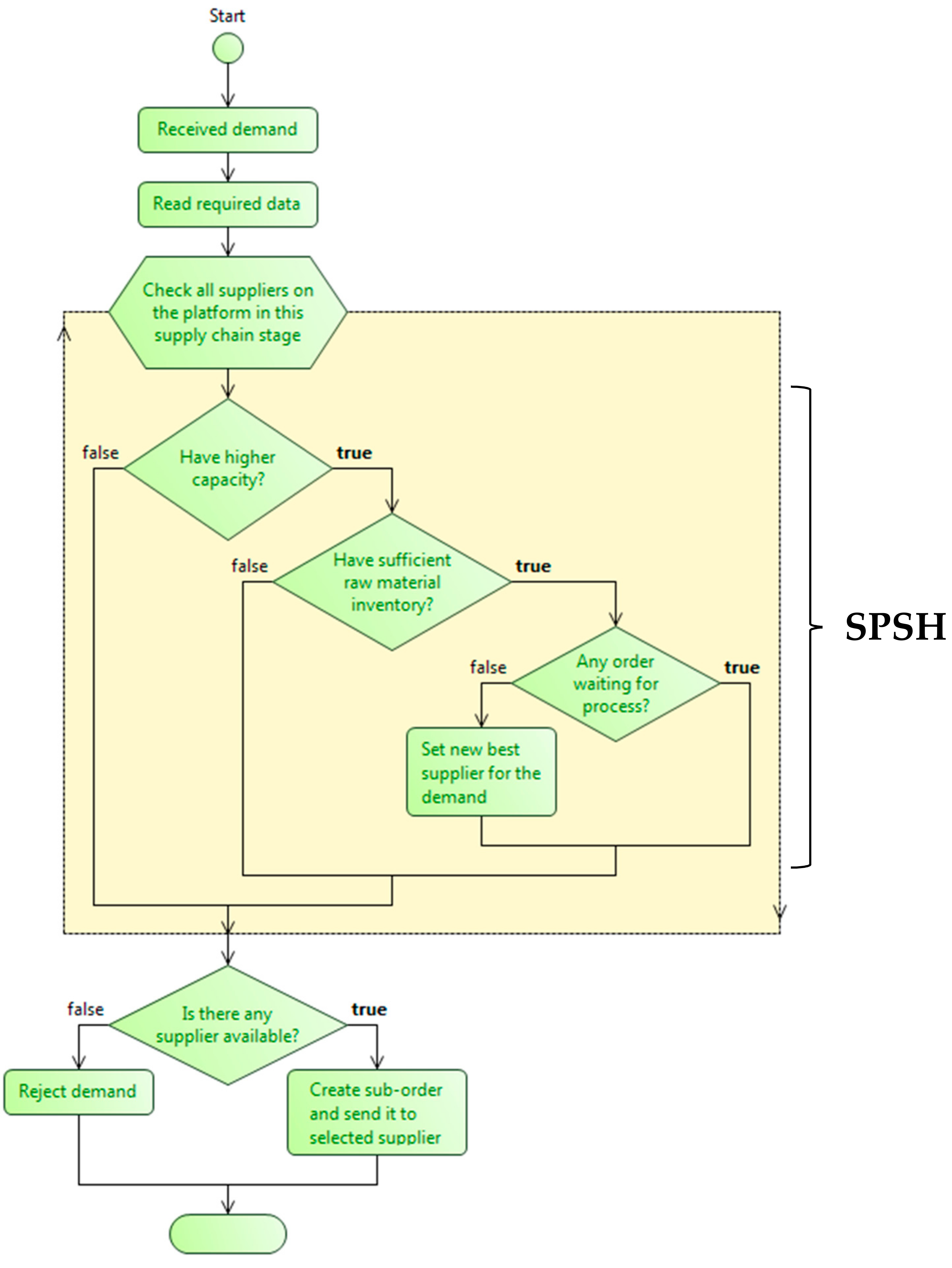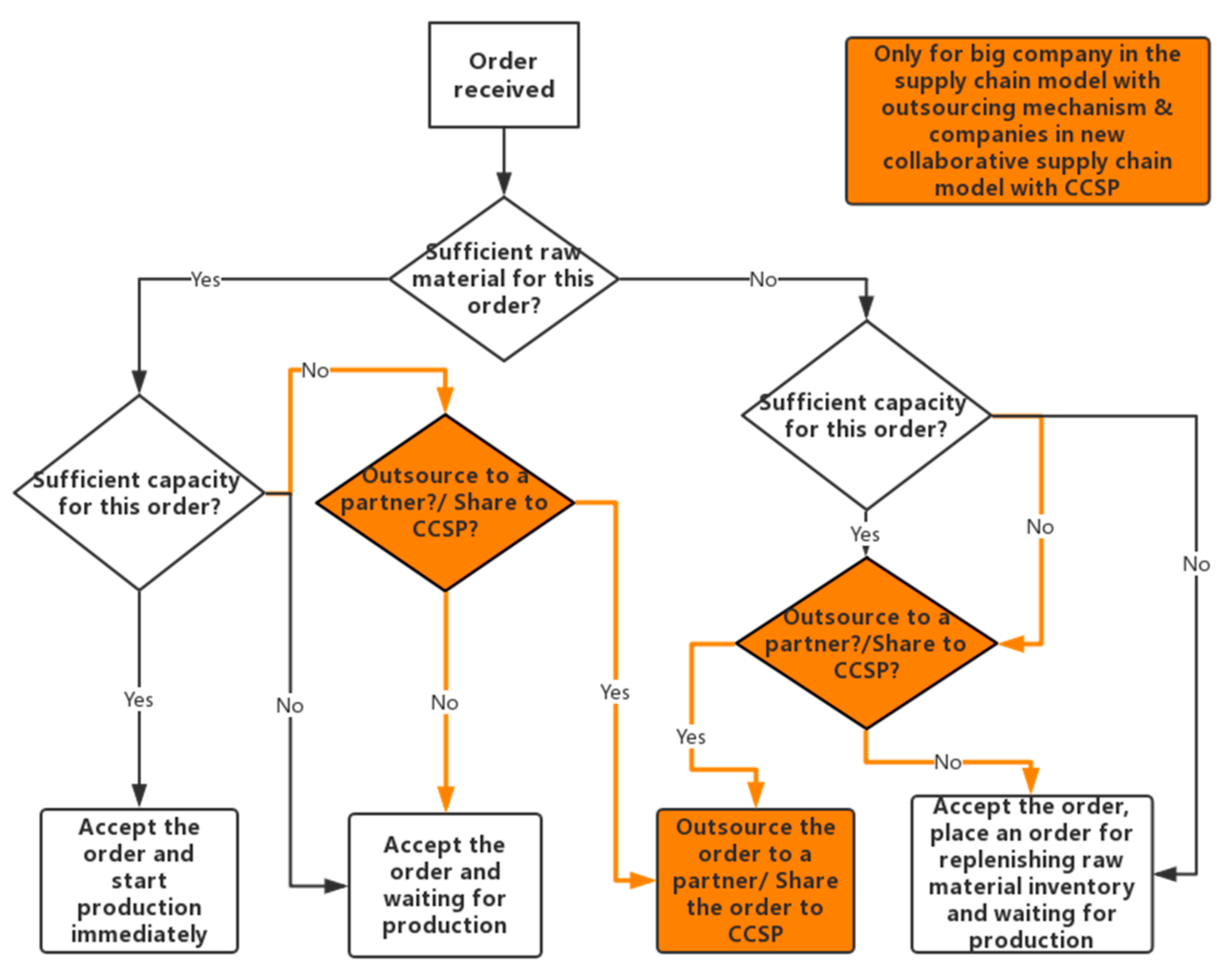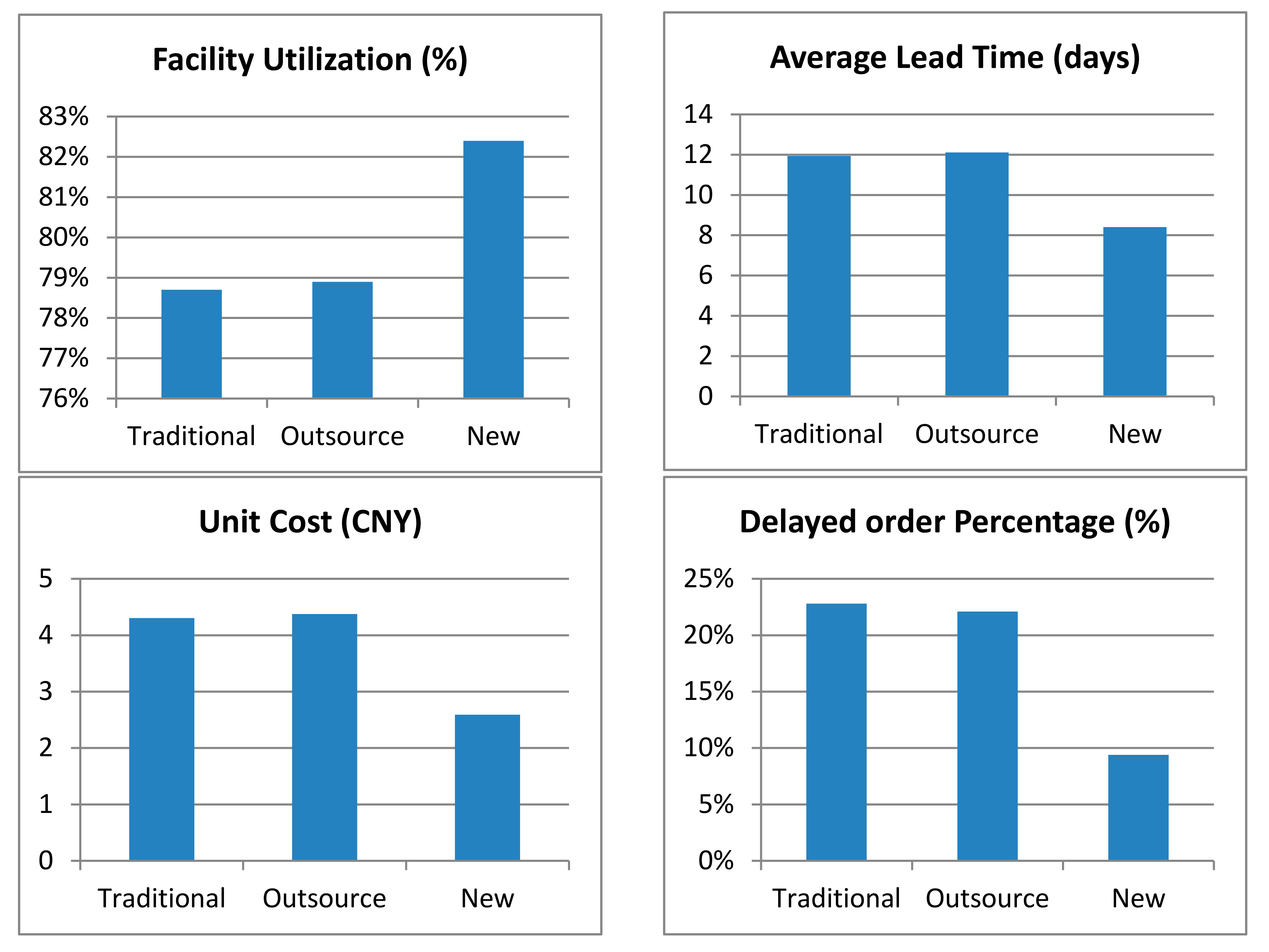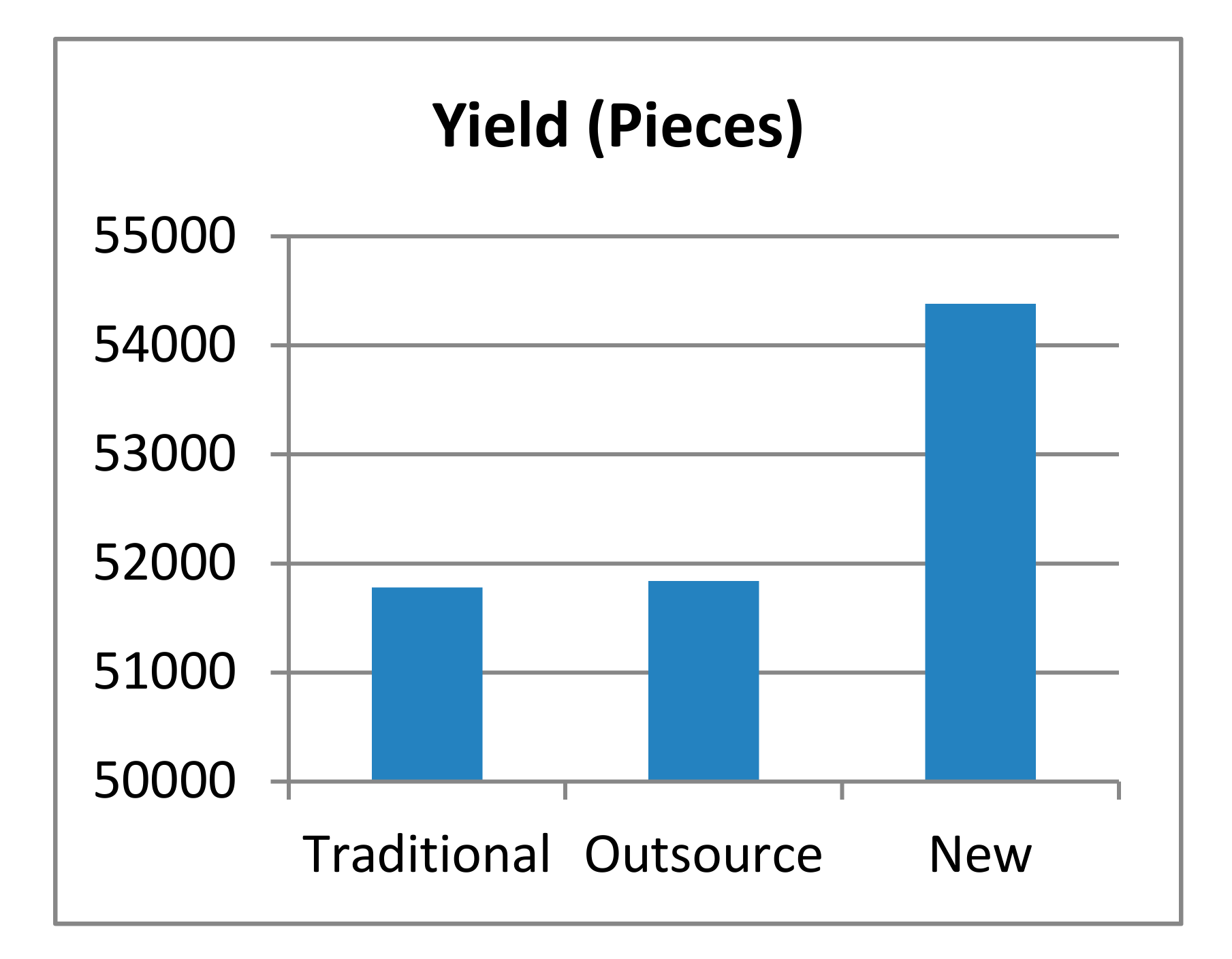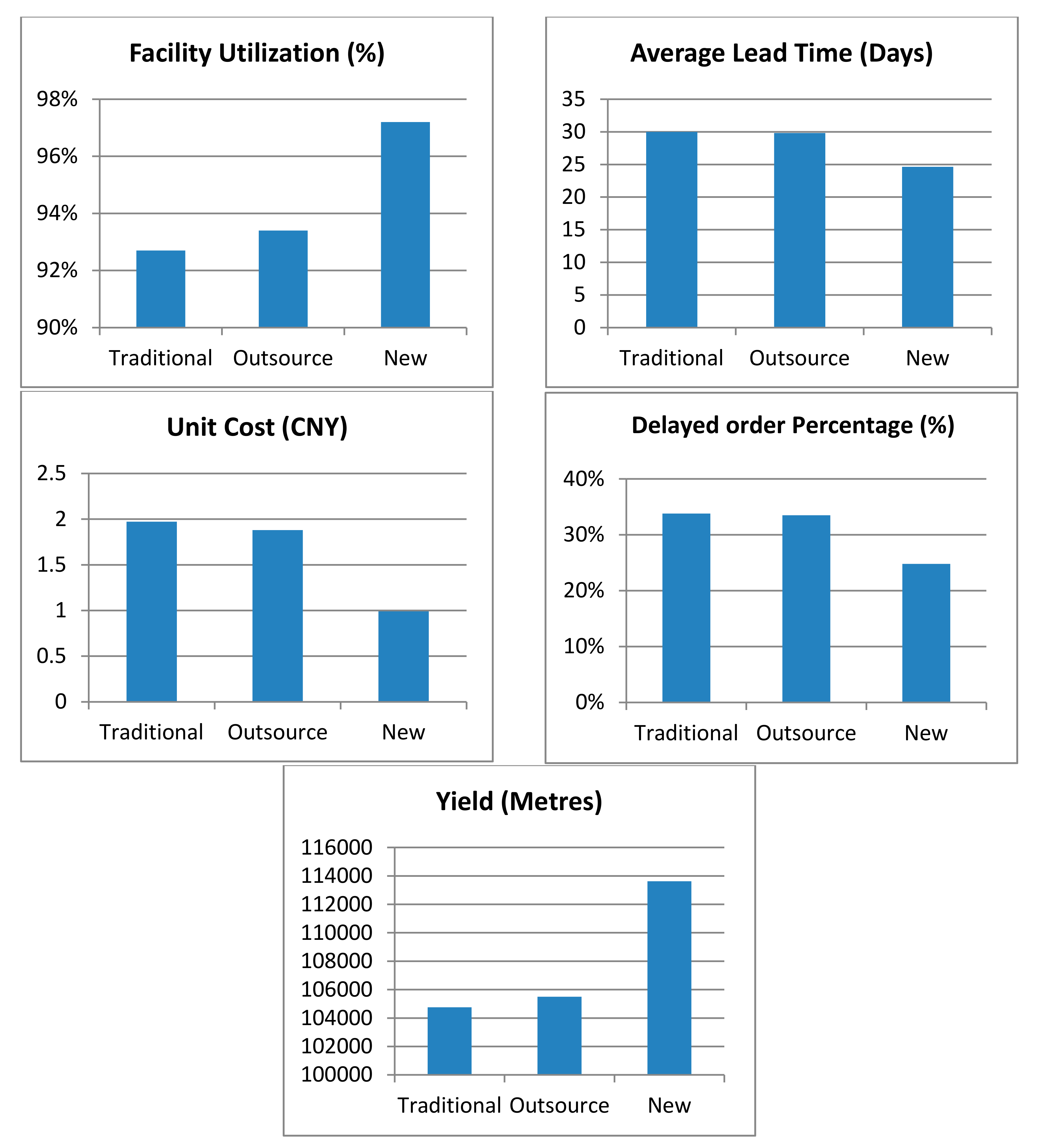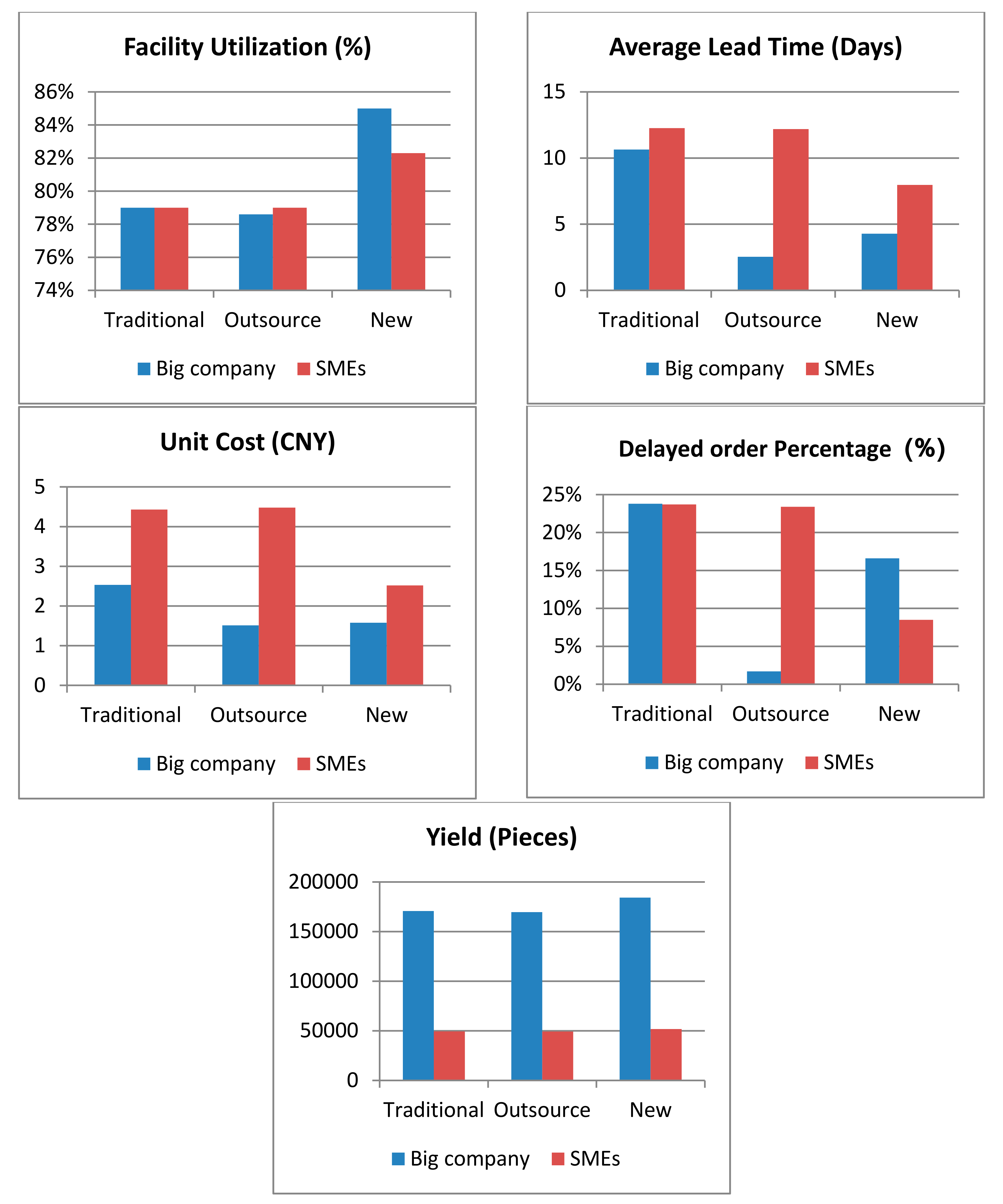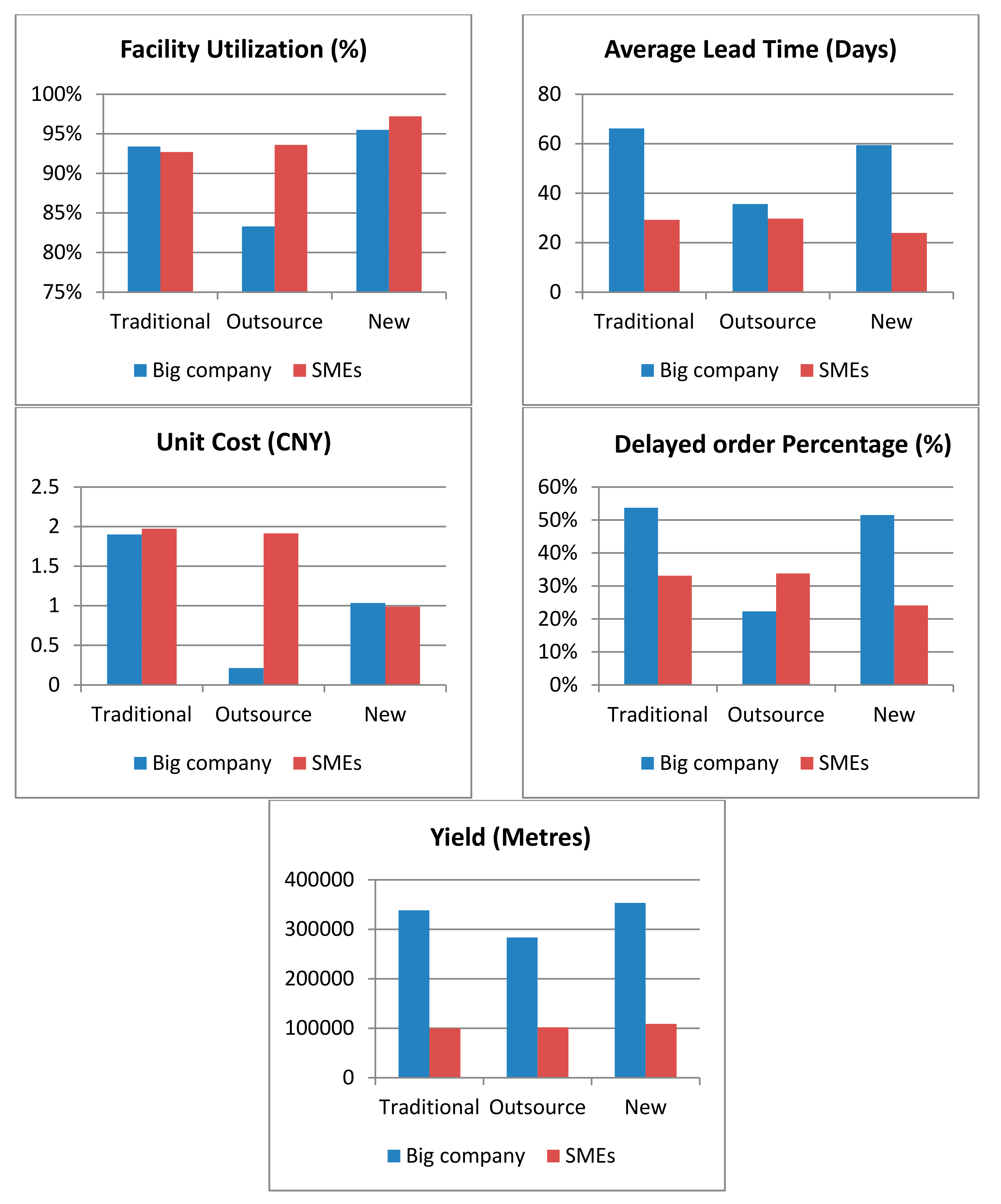1. Introduction
In today’s fashion market, more and more customers require customization and personalization in apparel design. Mass customization has become the mainstream in apparel production, which changes apparel production, leading to small series production and high diversity in production. Moreover, with the increasing of stochastic demands from customer in apparel market, forecast-based production becomes difficult in today’s apparel supply chain (SC), thus make-to-stock strategy is no longer appropriate. Therefore, make-to-order strategy, as a common strategy used to cope with these requirements, is employed by many manufacturers of apparel SC in recent years. Make-to-order strategy means that manufacturers starts production only after receiving a customer’s order; production and distribution processes in the SC are all triggered by customer orders [
1]. Besides the aforementioned advantages, such as meeting the desire for customization and reducing risk of forecast-based production, make-to-order strategy can also help companies avoid inventory of semi-finished products and final products which are unavoidable in make-to-stock strategy [
2]. However, the make-to-order strategy also incurs many additional issues, such as long lead time [
3], unsustainable relationships, high cost [
4] and unbalanced capacity. There are many constraints in traditional make-to-order apparel SC model (described in
Section 2.1 in detail) due to its defects. Customers always need to place an order to apparel manufacturer several months in advance for production. The order size should be big enough per order. Under such circumstance, late delivery still often occurs due to insufficient raw material or insufficient production capacity. Hence, traditional make-to-order SC model cannot be regarded as sustainable SC. Companies who can satisfy due dates set by customers and can shorten lead times could have a great competitive advantage. Therefore, traditional make-to-order apparel SC needs to be optimized for sustainability.
Supply chain collaboration (SCC), as an emerging concept and method in SC management in the past decades, plays a vital role in meeting the trend for sustainable SC. It has been regarded as one of the most important ways to realize sustainable SC and optimize SC performance. Many studies were conducted in SCC field. There are many methods used in SCC and they are all demonstrated in many studies as effective ways to improve SC performance, including profit sharing [
5,
6,
7], information sharing [
8,
9,
10], joint-decision making [
11,
12,
13] and resource sharing [
14,
15,
16]. In traditional make-to-order apparel SC, from fabric manufacturing echelon to apparel manufacturing echelon, each company always has a single supplier, forming independent SC structure without coordination. In today’s apparel SC, many companies use outsourcing mechanism (described in detail in
Section 2.2) for collaboration and optimizing resource distribution; however, it is a mechanism mainly used by big apparel companies but not by apparel SMEs (Small and medium enterprises). Therefore, it cannot be regarded as an optimized mechanism from a general supply chain scope, as it neglects apparel SMEs, which are an important part of today’s apparel SC. To the best of our knowledge, there is no study regarding developing sustainable SC among apparel SMEs.
In recent years, the concept of cloud manufacturing was raised [
17], although it is still under development. Cloud manufacturing “uses the network, cloud computing, service computing and manufacturing enabling technologies to transform manufacturing resources and manufacturing capabilities into manufacturing services, which can be managed and operated in an intelligent and unified way to enable the full sharing and circulating of manufacturing resources and manufacturing capabilities” [
18]. Concisely, customers send orders to a cloud manufacturing central system, and the central system selects the service provider for the customer. However, cloud manufacturing is only concentrated on manufacturing sector (one echelon in SC) but not from a series of SC echelons perspective. Cloud manufacturing is a totally centralized structure; the company can hardly maintain their own decision rights [
19], which is hardly accepted in the highly competitive apparel industry. Moreover, although there are several studies regarding cloud manufacturing, most only proposed the concept or model by introducing new structure or system, while no study evaluates its exact effect on SC performance based on experiment in real industry or through simulation technology. In this study, we propose a sustainable SC model by designing a collaborative cloud service platform to develop a “service to business to customer” (S2B2C) structure. Although the collaboration level among companies is enhanced, companies maintain their individual right to make decision of whether to keep an order or use the cloud service. The platform integrates multiple aforementioned SCC methods, e.g., information sharing, resource sharing, joint-decision making, etc. It aims at solving issues in existing make-to-order apparel SC models (e.g., traditional SC model and SC model with outsourcing mechanism) and increasing the sustainability of the whole SC. We utilized agent-based simulation technology to realize the platform and help us to answer several research questions in this study, including: Can our cloud platform bring more advantages to the whole SC? Is the novel model more beneficial to SMEs or to big companies? To what extent can they benefit from the novel model in terms of sustainable SC performance?
The structure of remaining paper is introduced as follows.
Section 2 introduces three make-to-order apparel SC models: traditional SC model, SC model with outsourcing mechanism and our new sustainable SC model. In
Section 3, the methodology used in this study is introduced. The problem is described by mathematical formulation while agent-based simulation technology is used for developing and experimenting three SC models. Experiment results and corresponding discussions are shown in
Section 4. Final conclusions are presented in
Section 5.
4. Results and Discussion
We run three SC models for 30 replications, respectively, in simulation for a duration of 180 days. For each replication, the seed of random number generator was same for three models to guarantee the validation of comparison. We processed output data and calculated five predefined KPIs of each company in each replication. Then, we calculated the average value of KPIs for big company, SMEs and whole cluster (all companies) in each SC echelon in each replication. As we assumed the inventory is infinite for fabric manufacturing echelon, we did not take companies in this SC echelon into consideration for further analysis. Finally, we obtained the range of each KPIs and also calculated the 95% confidence interval (CI) for mean of 30 replications. All corresponding statistics are shown in
Appendix A. The output data obtained by simulation of SC model with outsourcing mechanism are close to the real data we collected from the company in Jiangsu, China. Besides, we built our simulation model step by step, as introduced in
Section 3.2, and undertook strict debugging process. Therefore, our simulation model could be regarded as representative and validated to our case.
The comparisons of mean value of each KPIs of different clusters and companies are shown in
Figure 6,
Figure 7,
Figure 8 and
Figure 9. Based on
Figure 6 and
Figure 7, we can see that new proposed SC model performed much better for the whole apparel industry cluster in all aspects compared to traditional SC model and SC model with outsourcing mechanism. For apparel manufacturer cluster, the improvement was remarkable in the new model in terms of average lead time, unit cost and delayed order percentage: at least 29.62% improvement was obtained. For dyeing manufacturer cluster, the improvement was also significant in new model in terms of unit cost and delayed order percentage, with at least 26.63% improvement compared to the two other models. Therefore, our proposed SC model with CCSP is optimal choice for apparel industry cluster in each SC echelon. If we compare the SC model with outsource mechanism to traditional SC model, the difference is not significant at all: slight improvements were obtained in some aspects, while declines were also discovered in other aspects. Therefore, outsourcing mechanism cannot bring general benefits to the whole apparel industry cluster.
According to
Figure 8, we can see the influence of outsourcing mechanism and CCSP on apparel manufacturers of different scales. For big apparel manufacturers, outsourcing mechanism significantly increased their SC performance in all checked aspects, especially in terms of average lead time, unit cost and delayed order percentage, with a dramatic raise of 40.21–92.86% compared to traditional SC model. Outsourcing mechanism performed much better than new SC model with CCSP in these three aspects. However, its improvements were not as high as new SC model in terms of facility utilization and yield. This is because big manufacturers outsource many orders to their SME partners, thus they are not always in full workload. Therefore, outsourcing mechanism is a better choice for big apparel manufacturers. For apparel manufacturing SMEs, the effect is different. The performance of SC model with outsourcing mechanism and traditional SC model were almost the same in five checked aspects. We expected that SMEs could get increase in facility utilization and yield, as they may receive additional orders from big apparel manufacturers. However, it is not reflected in the simulation model. On the other hand, new sustainable model helps apparel manufacturing SMEs achieve dramatic upgrade in all five KPIs. Therefore, CCSP can bring comprehensive benefits to apparel SMEs.
According to
Figure 9, we can see the influence of outsourcing mechanism and CCSP on dyeing manufacturers of different scales. We can find similar pattern as the comparison for big apparel manufacturer. Remarkable improvements were obtained with outsourcing mechanism in terms of average lead time (a 46.11% decrease), unit cost (an 88.8% decrease) and delayed order percentage (a 58.47% decrease). However, there is also a 10.81% decrease in facility utilization and 16.20% decrease in yield of big dyeing manufacturer compared to traditional SC model, which are unexpected. Even though there is no dramatic difference between new sustainable model and traditional model, every checked KPI was improved to some extent in new sustainable model. For dyeing SMEs, we can get same conclusion as outcome for apparel manufacturing SMEs. SC performances of dyeing SMEs are almost the same in outsourcing mechanism and traditional model. Improvements in all aspects (from 4.85% to 49.87%) were achieved in new sustainable model for dyeing SMEs. Therefore, CCSP is the optimal scenario for dyeing SMEs in apparel SC.
5. Conclusions
In this study, we proposed a collaborative cloud service platform to create a sustainable make-to-order apparel supply chain model. A service provider selection heuristic was designed for the platform to select optimal supplier corresponding to each demand received by the platform. We utilized multi-agent-based simulation technology to build our proposed platform and to evaluate new sustainable SC model. We also conducted simulation experiment to compare our new model to traditional apparel make-to-order SC model and SC model with outsourcing mechanism. Based on simulation experiment results, we demonstrated the remarkable advantage of our proposed sustainable SC model with CCSP. We also obtained several conclusions:
In general, CCSP can bring comprehensive benefits to companies in every echelon of apparel SC, namely dyeing manufacturing echelon and apparel manufacturing echelon. CCSP integrates information sharing, resource sharing, joint decision-making and profit sharing into one novel sustainable SC model, which is an innovative approach to enhance supply chain sustainability and overcome defects in current make-to-order apparel SC.
The SPSH heuristics can provide optimal solution in decision-making for service provider selection. Therefore, optimal resource allocation was achieved in apparel SC, leading to significant improvements in multiple aspects of sustainable SC performance.
Outsourcing, as a widely used mechanism in apparel industry currently, is not an optimized choice in terms of SC sustainability for the whole cluster in apparel industry. There is no significant difference in terms of SC performance of whole cluster between make-to-order apparel SC model with outsourcing mechanism and traditional make-to-order apparel SC model.
Outsourcing mechanism is still an outstanding scenario for big company in apparel industry. Although our proposed new model can, to some extent, improve SC sustainable performance of big companies, outsourcing mechanism can bring much higher improvements in some aspects, e.g., average lead time, unit cost and delayed order percentage.
Our new sustainable model with CCSP helps apparel SMEs obtain dramatically enhanced performance in make-to-order apparel supply chain. It provides a service platform for small businesses in apparel industry to collaborate and share with each other for increasing both overall and individual competitive power. It is the optimal and desirable choice for apparel companies, especially apparel SMEs, to survive and become competitive in the future trend of sustainable SC.
In previous research, studies regarding cloud manufacturing mainly proposed the concept or model by introducing new structure or system, while no study evaluated its exact effect on SC performance. We obtained exact effect of CCSP on SC performance through multi-agent simulation to fill this gap. Moreover, we developed a sustainable make-to-order SC model by mainly considering the sustainable performance of apparel SMEs, which play an important part in today’s apparel industry. This was never done in previous practice or research. The outcome of this study could be applied in the whole apparel SC. Apparel companies, especially SMEs, could benefit from the cloud platform with corresponding sustainable SC model proposed in this study. Although this study is aiming at apparel industry, the conceptual model with collaborative cloud service platform can also be instructive to other industries: companies can implement CCSP to improve sustainability performance. The concept, structure and heuristic of CCSP can be a promising direction in future SC research; it can be also useful in several other popular aspects, such as Internet of Things, industry 4.0 and intelligent system. Such innovative model could also be a starting point for the ideal C2B model in future SC. However, there are also some limitations in this study. For example, we did not consider the influence of CCSP on logistics activities or its performance under different workload (busy season and idle season). It could also be very interesting to study the effect of CCSP on different aspects under distinct conditions in future research. Besides, CCSP only provides a platform for companies to share their redundant resource and orders which they cannot complete. It could be interesting to integrate more intelligent functions into the platform, e.g., sharing inventory or collaborative raw material purchase. They are all expected to be studied in future research.

